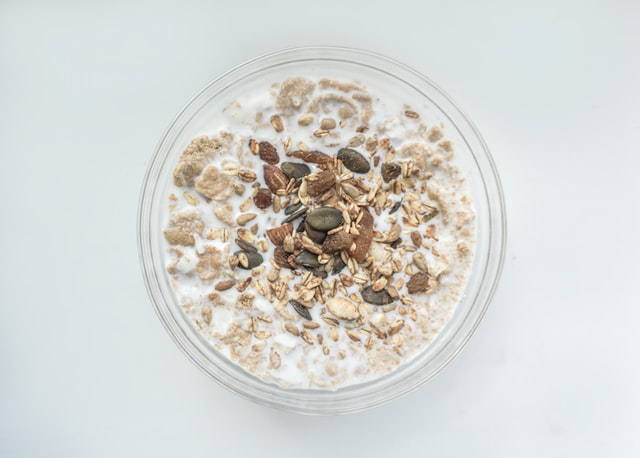MUESLI

Muesli has evolved from a hippie-health-food that traditionalists referred to as ‘bird seed’ to a contemporary canvas upon which to create your own bespoke wellness breakfast. How times have changed; it’s hip to eat healthy now.
Muesli is a mixture of rolled oats, grains, nuts, seeds and dried fruits and was developed around 1900 by a Swiss physician Maximilian Bircher-Brenner for patients in hospital (thus it’s health halo). And yes, you will recognize the name Bircher that today describes Bircher muesli, the moist version of muesli that has been soaked in liquid such as milk, yoghurt or fruit juice to soften the oats and usually contains grated apple. The word muesli comes from the Swiss German word mus which means mush. Fascinatingly, it was never intended as a breakfast food but rather as a starter similar to the way bread is offered now.
Today muesli is very much entrenched as a breakfast food and the soaked Bircher muesli is less commonly consumed as the dry version to which you add milk, (some are called ‘Swiss formula’ to reflect the history). It’s probably the modern requirement for fast ‘ready-to-eat’ cereals behind this change, although Bircher muesli has experienced a resurgence in more recent times. Modern healthy ‘ready-to-eat’ breakfast cereals contain a lot of muesli DNA (so to speak); they riff on the basic combination of flaked or puffed grains and muesli.
The health benefits of muesli are obvious – a collection of wholesome, plant foods with a good amount of fibre for gut health and phytonutrients for wellbeing. Muesli enhances the gut microbiome because the fibres it contains have a prebiotic effect that nurture gut bacteria. And if you enjoy it with a fermented food such as yoghurt or kefir, there may be an added probiotic effect from the live bacteria present. Glycemicindex.com shows GI figures from low to high because the GI of muesli very much depends on the ingredients (muesli recipes are more diverse than ever), although they tend toward low. Rolled oats are borderline low-med GI, and the dairy milk served with it is low. Nuts have a GI lowering effect, as does adding fat for toasted muesli. The GI can increase with the addition of other higher GI and/or highly processed grains (puffed, flaked etc) that are more easily digested and absorbed.
Toasted muesli has some fat added and baked to add crunch. Granola is muesli that has been mixed with sugar or honey and baked to make it crunchy and golden. Both these products have a higher kilojoule content as a result. I recommend using these as a topping to jazz-up a plain wholegrain cereal, or atop fresh fruit and yoghurt for an Instagram-worthy breakfast parfait. Muesli (or granola) bars can be a convenient and tasty way to enjoy wholegrains but remember once they are covered in chocolate or ‘yoghurt’ (which bears little resemblance to actual yoghurt), they may have swerved into ‘sometimes food’ territory, although definitely a better-for-you treat than a regular chocolate bar.
You can design your own muesli these days via specialty mail-order companies or do it yourself at your local bulk food store. Personalising food is a major global trend, and it’s fun.
Source: FSANZ, 2021
| Muesli, natural/untoasted, with dried fruit | |
| 4 Health Stars | |
| Glycemic index 48-62 | |
| Serving size – ½ Cup (60 g or 2.1 oz) | |
| Kilojoules | 988 |
| Calories | 236 |
| Protein | 6.5 |
| Fats – total | 6.5 |
| Includes: – Saturated fat | 1.8 |
| – Monounsaturated fat | 2.2 |
| – Polyunsaturated fat | 2.5 |
| Saturated : unsaturated fat ratio | 0.4 |
| Carbohydrates – Total | 41.1g |
| Available (Includes): | 35.5g |
| –Natural sugars | 7.7g |
| –Natural starches | 24.3g |
| –Added sugars | 3.5 |
| –Added starches | 0 |
| Unavailable (Includes): | 5.6g |
| –Dietary fibre | 5.6g |
| Sodium | 25mg |
| Glycemic load | 17-22 |
| Diabetes exchanges | 2 |
| Ingredients: rolled oats, dried fruit (including sultanas, currants, apricot, pawpaw, banana, apple and pineapple) and other ingredients including wheat bran, wheat germ, sugar, and/or seeds. Does not contain added vitamins or minerals. |

Nicole Senior is an Accredited Practising Dietitian, author, consultant, cook and food enthusiast who strives to make sense of nutrition science and delights in making healthy food delicious.
Contact: You can follow her on Twitter, Facebook, Pinterest, Instagram or check out her website







